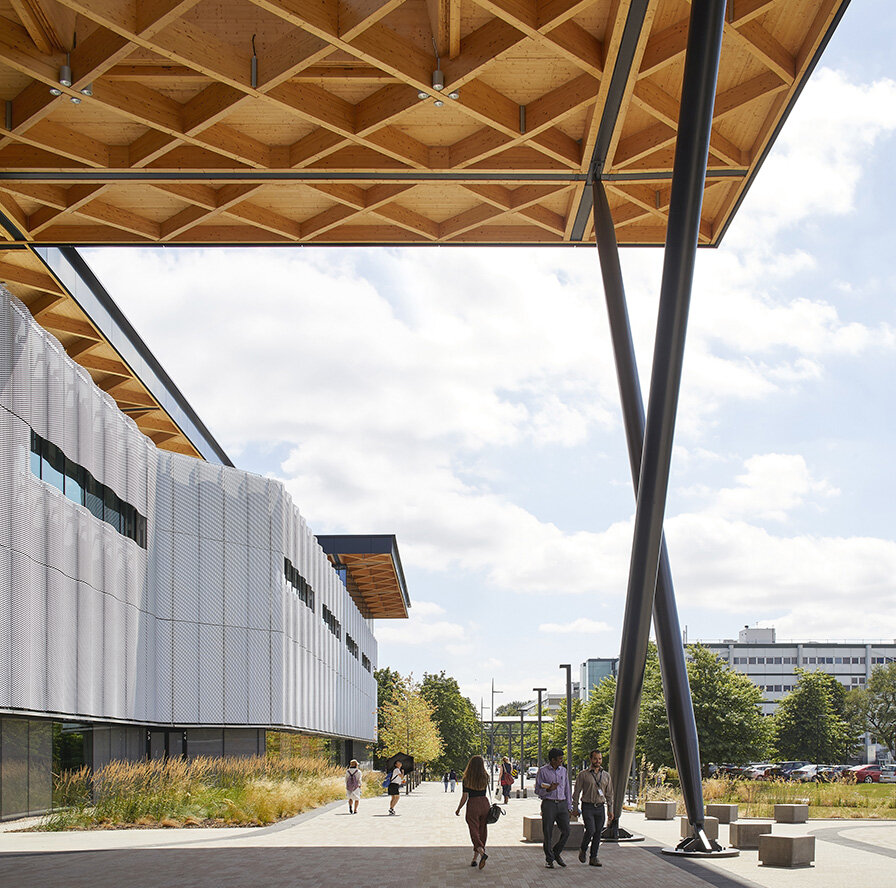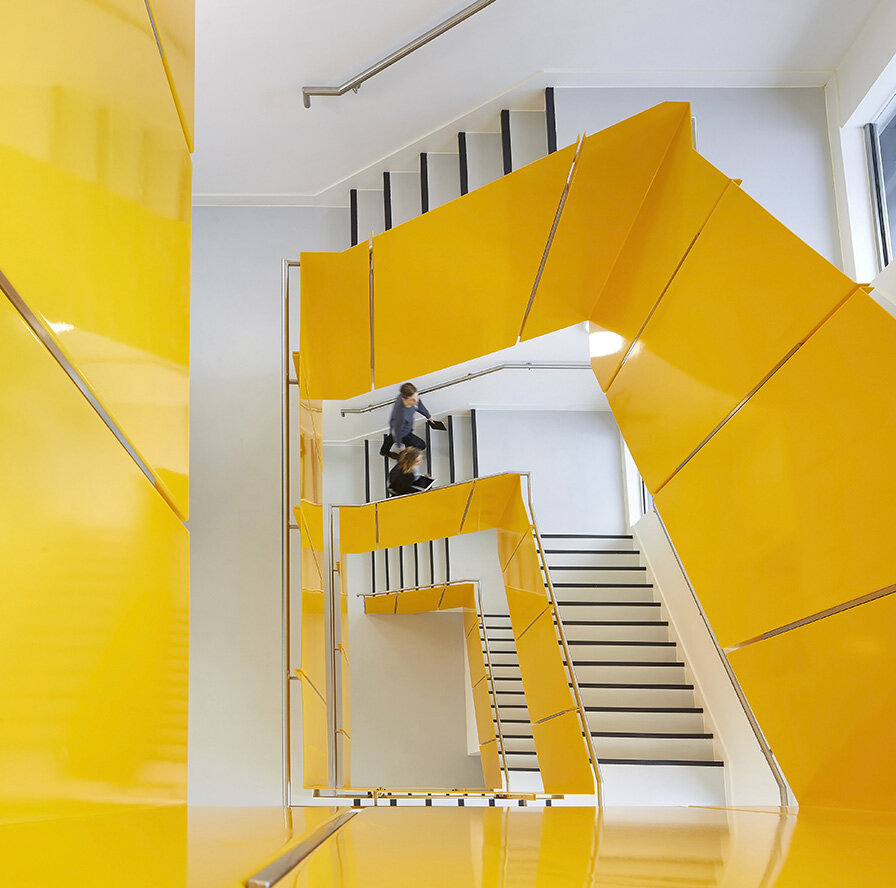NAIC - how collaboration can create success in complex projects
Designing the new RIBA National Award-winning NAIC building was an exceptionally ambitious, complex project – and a model for co-design in architecture.
Cullinan Studio led a process that brought together multiple parties in academia and industry, one which met their myriad individual requirements while maintaining a unified overall purpose and connecting positively to the natural world. The experience demonstrated how genuine collaboration in design can achieve results that would otherwise seem unimaginable.
The National Automotive Innovation Centre (NAIC), housed in the new Prof. Lord Bhattacharyya Building, is entirely unique. A partnership between WMG at the University of Warwick, Jaguar Land Rover and Tata Motors European Technical Centre, its purpose is to connect academic and manufacturing research in a collaborative environment. But more than that, it aims to inspire a new generation of engineers and to be a stimulus to the rebirth of West Midlands automotive design.
Such a vision demanded a new kind of building: one that could unite diverse parties and inspire collaborative working right in the heart of a university campus, yet also take into account the complex requirements of each party, most especially for privacy and IP security.
As the architects, it was immediately clear to us that this pioneering vision could only be turned into reality through a co-design process that was genuinely and comprehensively collaborative: with the three client partners; and with the various consultants and contractors, including Arup, RLB, Grant Associates, Balfour Beatty and their specialist suppliers.
What I have really loved about working on this project is that it represents a beacon of hope for a rebirth of manufacturing in the Midlands. There has been a collective will to make this happen and it has pushed clients and designers alike to come up with the best possible working environment for the brilliant research teams that seek a low carbon future for mobility.
Roddy Langmuir, Practice Leader, Cullinan Studio
The building’s success provides key lessons that can be applied to similarly complex projects: in academic-industrial partnerships or in any field involving multiple diverse parties, however challenging. Here are five insights from NAIC...
1. Establish fundamental principles – so you never lose sight of the big picture
From the outset we knew that NAIC would be a large, unusually complex assembly of spaces, so as architects the challenge was to design a building that would be immediately legible. We therefore looked for simplicity and a strength of purpose: a ‘big picture’ that would ultimately guide the process while we edited and managed the thousands of detailed decisions made by a large team of clients and consultants, all of which might confuse the essential visual clarity.
To achieve this a steering group, led by Cullinan Studio, agreed on a series of simple statements of objective, each debated and tested so that it had the buy-in of all parties. They were deliberately abstract statements – objectives like “To foster innovation and collaboration across disciplines”; and “To connect academic and manufacturing research” – but they clarified thinking and provided a solid basis for all decision-making throughout the design process.
The steering group was able to work through each client’s privacy and IP concern in this context, and in doing so the brief evolved from three distinct facilities with minimal shared space; to the three client partners being prepared to share a central hub; to an arrangement with the emphasis on shared space – everything from clay modelling workshops to Driving Simulation labs – and with the private space kept to an essential minimum.
Showing the works
NAIC’s Central Hall has a large window into the main engineering workshop: a space that in traditional research buildings would be hidden away ‘back of house’ due to IP concerns. But at NAIC the emphasis is on openness. The solution to this contradiction is a series of ‘hospital bed’-style curtains that give the flexibility to conceal any workshop bays that need to be kept private, while allowing all the building’s users and visitors to still feel like they are at the hub of the action as they move around the building or sit in meeting areas. The Hall’s visibility is therefore a constant reminder of NAIC’s unified purpose.
2. Find the positive parts of consensus
Collaboration requires consensus – but often ‘consensus’ is primarily negative: it’s easy to agree the things that can’t be done. For architects, the challenge is to be willing to listen, and to find the positive, additive elements of consensus.
At Cullinan Studio we work well with diverse teams and complex organisations because collaboration is our founding principle. Our cooperative structure has always meant that we share responsibilities across the practice and all issues are worked through and debated on their merits: decisions can’t simply be overturned by seniority.
In a complex architectural project like NAIC it was essential to get results that had real weight and buy-in. Cullinan Studio used peer group workshops at different levels of seniority, ensuring people were comfortable enough to provide genuine feedback without feeling watched by seniors. We also facilitated feedback between peer groups in ‘town hall’ style meetings. Ideas articulated in this way have more credence than if merely stated by the architect, and a positive consensus emerges; even though the architect must ultimately recompose those ideas (and the thousands of other factors and inputs) into a design that works on every level.
Mismatched furniture
Constructive consensus applies to even the details of a successful building. Jaguar Land Rover and Tata each tested their own styles of desk arrangement and furniture for NAIC. We encouraged them to agree to use a mix and (mis)match of very different furniture styles brought together in each setting. The result is that the work and meeting spaces feel friendlier, warmer and much less authoritarian than typical office buildings - ideally suited to fostering a spirit of collaboration.
3. Be prepared to do things that have never been done before
No project quite like NAIC has ever been undertaken before, so it was inevitable that its building would be highly innovative: indeed, unlike any other in existence.
Research buildings are normally hidden away in industrial parks, surrounded by car parks and tree screening for IP reasons. For NAIC, we were able to turn this model on its head, allowing the default design modus operandi to be ‘openness’ in a building located in the heart of the university campus – an approach crucial to achieving the desired culture of innovation. Whereas most research buildings deliver the message ‘Go away’, NAIC says ‘Come on in’.
The timber roof
The materials that might be associated with the automotive industry are steel, aluminium, glass… but not timber. NAIC’s building has an exposed timber structure and is covered by the largest timber roof in Europe, which is visible from every part of the building. It is an expression of a brand new approach, signalling a change in attitude of the whole automotive industry towards sustainability, low carbon mobility and its relationship with the environment.
4. Take ideas from every sector
If a project brings together clients from diverse sectors, it makes no sense to be constrained by particular architectural traditions in one of those sectors.
Cullinan Studio’s own flat and fluid structure encourages connections across partners with diverse skills that are generative of new possibilities, so it is natural for us to bring ideas and lessons learned from one specialist sector across to inform others.
No corridors
NAIC’s approach to circulation of the building’s users is one we’ve used in very different academic projects. We know that innovation often arises through chance encounters between individuals across disciplines, so rather than corridors that simply take you from A to B, the building’s circulation channels are spaces in their own right where people can stop and meet. A good example is NAIC’s gentle staircase which takes users up through the building instead of lifts: a perfect walking-talking space with seating between flights.
5. Put wellbeing at the heart of the building design
If a building is to fulfil its purposes of fostering collaboration and inspiring a new generation of engineers, it must have the happiness and wellbeing of its users at its heart.
We believe that means connecting people to nature through architecture. This is something that informs our practice in all its work.
Connection to nature
NAIC is unlike traditional research buildings in its sense of closeness to the natural world. Huge skylights mean there is daylight everywhere. A rippling façade of curving expanded mesh acts as a veil to direct sunlight, and creates ever shifting patterns of light and shade under Coventry skies. There are views out onto the campus landscape from a seated position to rest one’s eyes from the screen, and the canopy of trees gives a green backdrop to long views across the building’s interior. Balconies and communal terraces at multiple levels connect the inside to out, while the wavy-seating along the water feature draws people into contact with the natural habitats and biodiversity along the circulation routes.
The scale, complexity and technical diversity of the range of spaces in the NAIC building is almost unparalleled – yet it has an overriding sense of calm, simplicity and unity of purpose that is immediately obvious to the visitor.
That achievement is a reflection of the design process of the building: a collaboration between multiple diverse parties, facilitated by architects who take ultimate responsibility for delivering the vision. At Cullinan Studio we have always worked by collaboration – and we believe that today, as traditional boundaries are disrupted, this has never been more relevant and valuable.
Design Team
Client Partners: WMG, University of Warwick, Tata Motors, Jaguar Land Rover
QS and Project Manager: RLB
Civil, Structural and Services Engineer: Arup
Landscape Architect: Grant Associates
Fire Engineer: Buro Happold and Fire Guidance
Acoustician: Buro Happold
Planning Consultant: Turley
Main Contractor: Balfour Beatty
Specialist Lighting: Arup
Signage / Wayfinding: Maynard






